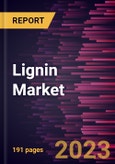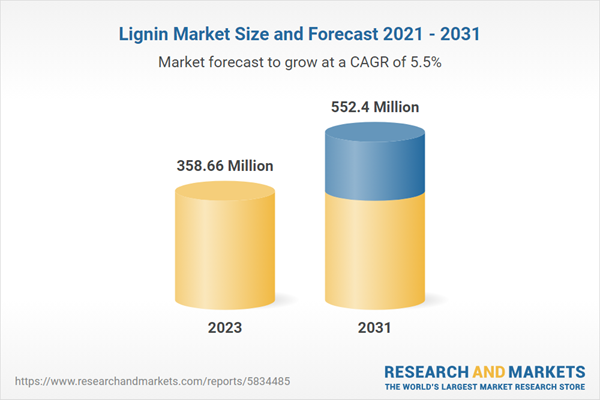The lignin market size was valued at US$ 358.66 million in 2023 and is projected to reach US$ 552.40 million by 2031; it is estimated to register a CAGR of 5.5% from 2023 to 2031
Lignin is widely available as a by-product of the paper and pulp industry. It is getting immense traction for a variety of applications such as concrete additives, plastics and polymers, dyes and pigments, water treatment chemicals, and fertilizers, owing to its superior binding and dispersing properties. In the plastic and polymers industry, it is significantly substituting petroleum-based products such as phenolic resins. Further, lignin is also becoming popular as a low-cost and sustainable alternative to various fossil fuel-based resins. The rising demand for environmentally friendly alternatives to fossil-fuel-based products and the wide application scope of lignin drive the global market growth.
Lignin manufacturers are investing significantly in strategic development initiatives such as product innovations, mergers and acquisitions, and expansion of their businesses to attract a broad customer base and enhance their market position. Moreover, the demand for lignin is increasing among end-use industries due to rising environmental concerns and sustainability issues. For instance, in December 2021, Nippon Paper (Japan) and Stora Enso Oyj (Finland) signed a partnership agreement to use trees to revolutionize the battery industry. Their research focused on the replacement of lithium-ion and rare-metal batteries with lignin. Similarly, in January 2023, Lignovations, an Austria-based company that develops natural functional ingredients from lignin, developed LignoGuard, a multifunctional ingredient produced from woodchips, sawdust, and low-quality hardwood.
The product aids in reducing synthetic UV filters and minerals required for photoprotection. It can be used as a natural antioxidant and emulsion stabilizer and applied to sensitive skin. Such product innovations help companies to gain a competitive advantage in international markets.
Based on form, lignin market is categorized into solid and liquid. In 2022, the solid segment dominated the global lignin market. Manufacturers in the lignin market provide lignin in the form of powder and granules for various end-use applications. Powdered and granular lignin is manufactured by drying lignin using a pre-drying method, followed by an additional drying process in a drying apparatus. These forms of lignin are largely preferred owing to various benefits such as ease of transportation, reduced water content, and good binder capability. A few of the key players, including Borregaard AS, DOMSJö FABRIKER AB, Nippon Paper Industries Co Ltd, and Stora Enso Oyj, offer powder and granular lignin. The powdered and granular form of lignin can be used in various applications such as concrete admixtures, activated carbon, and plastics and polymers, as they can be easily mixed while manufacturing different products.
A few players operating in the lignin market include Nippon Paper Industries Co Ltd, Borregaard ASA, Burgo Group SpA, Domsjo Fabriker AB, Sappi Ltd, Stora Enso Oyj, Suzano SA, The Dallas Group of America Inc, Tokyo Chemical Industry Co Ltd, West Fraser Timber Co Ltd, among others. Players operating in the lignin market focus on product innovation and research & development to offer innovative products to cater to the emerging consumer demand.
The overall lignin market size has been derived using both primary and secondary sources. To begin the research process, exhaustive secondary research has been conducted using internal and external sources to obtain qualitative and quantitative information related to the market. Also, multiple primary interviews have been conducted with industry participants to validate the data and gain more analytical insights into the topic. The participants of this process include industry experts such as VPs, business development managers, market intelligence managers, and national sales managers - along with external consultants such as valuation experts, research analysts, and key opinion leaders - specializing in the lignin market.
Lignin is widely available as a by-product of the paper and pulp industry. It is getting immense traction for a variety of applications such as concrete additives, plastics and polymers, dyes and pigments, water treatment chemicals, and fertilizers, owing to its superior binding and dispersing properties. In the plastic and polymers industry, it is significantly substituting petroleum-based products such as phenolic resins. Further, lignin is also becoming popular as a low-cost and sustainable alternative to various fossil fuel-based resins. The rising demand for environmentally friendly alternatives to fossil-fuel-based products and the wide application scope of lignin drive the global market growth.
Lignin manufacturers are investing significantly in strategic development initiatives such as product innovations, mergers and acquisitions, and expansion of their businesses to attract a broad customer base and enhance their market position. Moreover, the demand for lignin is increasing among end-use industries due to rising environmental concerns and sustainability issues. For instance, in December 2021, Nippon Paper (Japan) and Stora Enso Oyj (Finland) signed a partnership agreement to use trees to revolutionize the battery industry. Their research focused on the replacement of lithium-ion and rare-metal batteries with lignin. Similarly, in January 2023, Lignovations, an Austria-based company that develops natural functional ingredients from lignin, developed LignoGuard, a multifunctional ingredient produced from woodchips, sawdust, and low-quality hardwood.
The product aids in reducing synthetic UV filters and minerals required for photoprotection. It can be used as a natural antioxidant and emulsion stabilizer and applied to sensitive skin. Such product innovations help companies to gain a competitive advantage in international markets.
Based on form, lignin market is categorized into solid and liquid. In 2022, the solid segment dominated the global lignin market. Manufacturers in the lignin market provide lignin in the form of powder and granules for various end-use applications. Powdered and granular lignin is manufactured by drying lignin using a pre-drying method, followed by an additional drying process in a drying apparatus. These forms of lignin are largely preferred owing to various benefits such as ease of transportation, reduced water content, and good binder capability. A few of the key players, including Borregaard AS, DOMSJö FABRIKER AB, Nippon Paper Industries Co Ltd, and Stora Enso Oyj, offer powder and granular lignin. The powdered and granular form of lignin can be used in various applications such as concrete admixtures, activated carbon, and plastics and polymers, as they can be easily mixed while manufacturing different products.
A few players operating in the lignin market include Nippon Paper Industries Co Ltd, Borregaard ASA, Burgo Group SpA, Domsjo Fabriker AB, Sappi Ltd, Stora Enso Oyj, Suzano SA, The Dallas Group of America Inc, Tokyo Chemical Industry Co Ltd, West Fraser Timber Co Ltd, among others. Players operating in the lignin market focus on product innovation and research & development to offer innovative products to cater to the emerging consumer demand.
The overall lignin market size has been derived using both primary and secondary sources. To begin the research process, exhaustive secondary research has been conducted using internal and external sources to obtain qualitative and quantitative information related to the market. Also, multiple primary interviews have been conducted with industry participants to validate the data and gain more analytical insights into the topic. The participants of this process include industry experts such as VPs, business development managers, market intelligence managers, and national sales managers - along with external consultants such as valuation experts, research analysts, and key opinion leaders - specializing in the lignin market.
Reasons to Buy:
- Save and reduce time carrying out entry-level research by identifying the growth, size, leading players, and segments in the global lignin market
- Highlights key business priorities in order to assist companies to realign their business strategies
- The key findings and recommendations highlight crucial progressive industry trends in the global lignin market, thereby allowing players across the value chain to develop effective long-term strategies
- Develop/modify business expansion plans by using substantial growth offering developed and emerging markets
- Scrutinize in-depth global market trends and outlook coupled with the factors driving the lignin market as well as those hindering it.
- Enhance the decision-making process by understanding the strategies that underpin commercial interest with respect to client products, segmentation, pricing, and distribution
Table of Contents
1. Introduction
2. Executive Summary
3. Research Methodology
4. Lignin Market Landscape
5. Lignin Market - Key Market Dynamics
6. Lignin Market - Global Market Analysis
7. Lignin Market Volume and Revenue Analysis - by Type
8. Lignin Market Revenue Analysis - by Form
9. Lignin Market Revenue Analysis - by Application
10. Lignin Market - Geographical Analysis
11. Competitive Landscape
12. Lignin Industry Landscape
13. Company Profiles
14. Appendix
Companies Mentioned
- Lignin Market
- Nippon Paper Industries Co Ltd
- Borregaard ASA
- Burgo Group SpA
- Domsjo Fabriker AB
- Sappi Ltd
- Stora Enso Oyj
- Suzano SA
- The Dallas Group of America Inc
- Tokyo Chemical Industry Co Ltd
- West Fraser Timber Co Ltd
Table Information
| Report Attribute | Details |
|---|---|
| No. of Pages | 322 |
| Published | August 2024 |
| Forecast Period | 2023 - 2031 |
| Estimated Market Value in 2023 | 358.66 Million |
| Forecasted Market Value by 2031 | 552.4 Million |
| Compound Annual Growth Rate | 5.5% |
| Regions Covered | Global |
| No. of Companies Mentioned | 11 |









